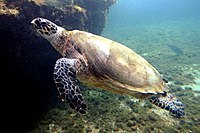
Photo from wikipedia
The Eastern Pacific hawksbill sea turtle population is one of the most endangered of all sea turtle species. Here, we examine the foraging ecology of 47 hawksbill turtles (40.5-90.3 cm CCL,… Click to show full abstract
The Eastern Pacific hawksbill sea turtle population is one of the most endangered of all sea turtle species. Here, we examine the foraging ecology of 47 hawksbill turtles (40.5-90.3 cm CCL, mean = 54.1 ± 10.1 cm) around Isla San José, Gulf of California, Mexico by integrating information from passive acoustic telemetry, behavior recordings, fecal analysis, and habitat surveys. Tagged hawkbill turtles exhibited high site fidelity over months and years (tracking duration 1-1490 days, mean = 255 ± 373 days) to the location and benthic habitat where individuals were initially caught. Diet was dominated by benthic invertebrates and algae including sponges, algae, tunicates, and mangrove roots. The mean percent cover of these benthic food items was significantly greater in the mangrove estuary than in adjacent rocky and sandy reef habitats. The Isla San José foraging ground is a high-use area for hawksbills and should be granted national protection status.
Journal Title: Marine environmental research
Year Published: 2021
Link to full text (if available)
Share on Social Media: Sign Up to like & get
recommendations!